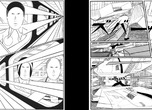
Posted: Mon May 17 2010
Stephen Lebovits, Editor
That’s a flashy scooter.
SL: It’s pretty cool, huh? Once a month a different artist will ‘bomb’ my scooter with their art.
Once a month?
SL: That’s right. I’m working at for Design Festa at the Design Festa Gallery in Harajuku and once a month a different artist will paint the scooter. I let one artist do it at first, and then I got the idea that this could be a sort of rolling platform for artists. There are a lot of scooters in Tokyo, which – when it comes down to it – is potential for a lot of mobile art work. This could be a way for people to individualise their scooters and give independent artists a way to show their work that is out of the ordinary.
What’s Design Festa and the gallery about?
SL: I thought it was as popular as McDonalds – that everyone knew about it. On the Japanese side, that’s true. When you talk to Japanese people and mention Design Festa, they know what it is; other people, not so much. [Laughs] Basically, 15 years ago a designer saw that there were all kinds of events for photography, fashion, illustration and the like but no one big event for all of them, and she wanted to do a kind of mash-up. So, she threw the first event 15 years ago at Makuhari Messe. She didn’t know how popular it would be; she went all over the country with a bag of flyers, and on the first day there were 800 people waiting to get in. From there is just steamrolled. Now, we have the event twice a year, and the gallery in Harajuku too. This year’s festivals are on May 15 and 16, and then we will have another on November 6 and 7. Over 8,500 artists from all over the world come to Tokyo Big Sight for two days of all kinds of things from painting, drawing, sculpture, crafts down to music, dance and performance art. We also have the gallery, too and it’s open all year round in Harajuku. There are exhibition spaces, a café and people show anything here – they even throw small events.
8,500 people - that’s a lot. So it’s different than Geisai?
SL: Yeah, there are. Design Festa’s been around longer, and we’re not as curated. Really, it’s first come, first served – so anyone who wants to do anything can join up. There’s no panel of judges who look at the works; you rent your space and do whatever you want in that space as long as no one will get hurt or something. So, similar yet much different. We want it to be a kind of vortex of art chaos. Japan’s pretty structured when it comes to showing art and galleries, and we want the festival and the gallery to give anyone someplace to show their work. You can even buy items from the artists.
Are you an artist yourself?
SL: Yeah, I do art too. I do photography, but I do lots of different things. Two days a week I work at the Design Festa Gallery, once a week I work at a bookshop in Takadanobaba, and I also edit the English-Japanese bilingual magazine Hiragana Times. It’s interesting, and I’m always looking to do more.
When did you first come to Japan?
SL: I first came to Japan about nine years ago, on my honeymoon. My wife and I got married and we didn’t take our honeymoon until a year later. It was a whirlwind honeymoon from Montreal to Los Angeles, then Thailand, Japan, England then back to Montreal.
So you’re from Montreal.
SL: Yup. Originally I had wanted to go China – my wife is Canadian-Chinese – and she didn’t want to be translating for me the whole time so we decided to go somewhere else and we chose Japan. We met some really funky people and enjoyed the vibe of the city, and when we went back we realised that there wasn’t really anything tying us down, so we thought that we would go back to Japan. Now, my wife teaches at a private high school, and we like it so much here we can’t find any reasons to go back. When I call home, my mother often asks, ‘When are you coming back?’ That’s a hard question to answer. [Laughs]
So where around here is good for lunch?
SL: Well, there’s a pretty good lunch at the gallery café. The dishes look a little small in the photos on the menu, but it’s actually really big and pretty cheap too. You get a chicken, rice and salad for ¥500. There’s also a little curry van that I sometimes stop at that’s really tasty too. They’re there from Monday to Friday from and the literally pull into a parking spot, pop open the back and sell ¥500 yen curries. At like two o’clock the prices drop because they have to get rid of their food. [Laughs] I used to go to Wendy’s sometimes, but they’re gone now.
What about Japanese food?
SL**: I like it but natto’s not really my thing. Most people don’t like the smell, but for me it’s the texture – it’s like eating rubber bands.
More from Stephen:

‘When you first get here, things like getting on the Chuo Line are amazing, but now – not so much, so I switched to a scooter. On the scooter you get a totally different view of the city. I ride around with my camera slung over my shoulder, and when I’m stopped for a bit I snap some pictures.’
‘Tokyo is a really hectic place, but every day is a new adventure and that’s what makes it so great.’
‘One of my favourite places is Kichijoji, because I like to take photos there are lots of little streets and lanes there that make great shots. Inokashira Park is cool because you can go hang out there with a chu-hi and play the bongos.’ [Laughs]
Tags:
Tweets
- About Us |
- Work for Time Out |
- Send us info |
- Advertising |
- Mobile edition |
- Terms & Conditions |
- Privacy policy |
- Contact Us
Copyright © 2014 Time Out Tokyo
















Add your comment